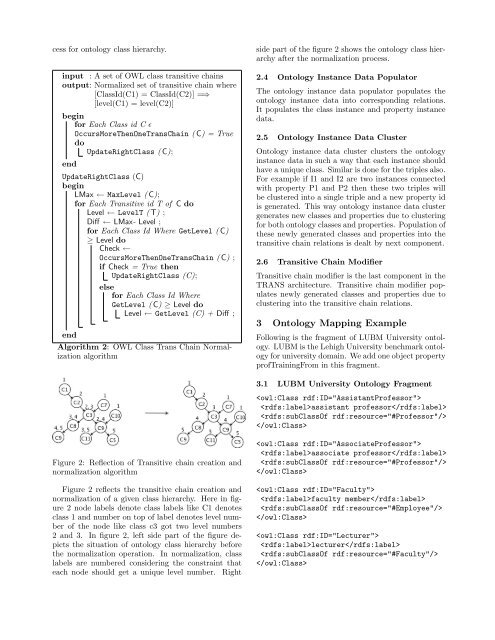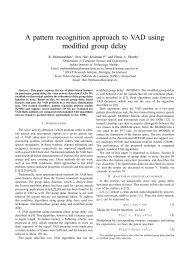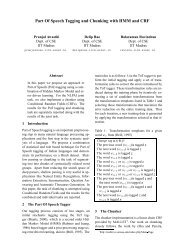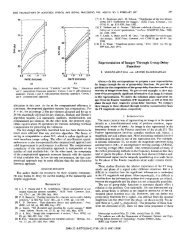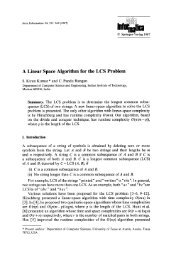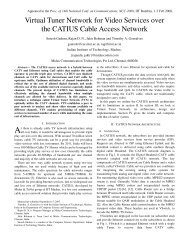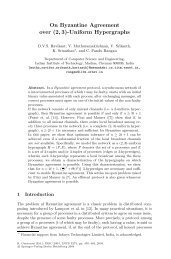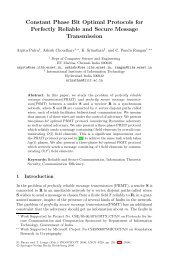TRANS: Schema-Aware Mapping of OWL Ontologies into Relational ...
TRANS: Schema-Aware Mapping of OWL Ontologies into Relational ...
TRANS: Schema-Aware Mapping of OWL Ontologies into Relational ...
You also want an ePaper? Increase the reach of your titles
YUMPU automatically turns print PDFs into web optimized ePapers that Google loves.
cess for ontology class hierarchy.<br />
input : A set <strong>of</strong> <strong>OWL</strong> class transitive chains<br />
output: Normalized set <strong>of</strong> transitive chain where<br />
[ClassId(C1) = ClassId(C2)] =⇒<br />
[level(C1) = level(C2)]<br />
begin<br />
for Each Class id C ɛ<br />
OccursMoreThenOneTransChain ( C) = True<br />
do<br />
UpdateRightClass ( C);<br />
end<br />
UpdateRightClass (C)<br />
begin<br />
LMax ← MaxLevel ( C);<br />
for Each Transitive id T <strong>of</strong> C do<br />
Level ← LevelT ( T) ;<br />
Diff ← LMax- Level ;<br />
for Each Class Id Where GetLevel ( C)<br />
≥ Level do<br />
Check ←<br />
OccursMoreThenOneTransChain ( C) ;<br />
if Check = True then<br />
UpdateRightClass (C);<br />
else<br />
for Each Class Id Where<br />
GetLevel ( C) ≥ Level do<br />
Level ← GetLevel (C) + Diff ;<br />
end<br />
Algorithm 2: <strong>OWL</strong> Class Trans Chain Normalization<br />
algorithm<br />
side part <strong>of</strong> the figure 2 shows the ontology class hierarchy<br />
after the normalization process.<br />
2.4 Ontology Instance Data Populator<br />
The ontology instance data populator populates the<br />
ontology instance data <strong>into</strong> corresponding relations.<br />
It populates the class instance and property instance<br />
data.<br />
2.5 Ontology Instance Data Cluster<br />
Ontology instance data cluster clusters the ontology<br />
instance data in such a way that each instance should<br />
have a unique class. Similar is done for the triples also.<br />
For example if I1 and I2 are two instances connected<br />
with property P1 and P2 then these two triples will<br />
be clustered <strong>into</strong> a single triple and a new property id<br />
is generated. This way ontology instance data cluster<br />
generates new classes and properties due to clustering<br />
for both ontology classes and properties. Population <strong>of</strong><br />
these newly generated classes and properties <strong>into</strong> the<br />
transitive chain relations is dealt by next component.<br />
2.6 Transitive Chain Modifier<br />
Transitive chain modifier is the last component in the<br />
<strong>TRANS</strong> architecture. Transitive chain modifier populates<br />
newly generated classes and properties due to<br />
clustering <strong>into</strong> the transitive chain relations.<br />
3 Ontology <strong>Mapping</strong> Example<br />
Following is the fragment <strong>of</strong> LUBM University ontology.<br />
LUBM is the Lehigh University benchmark ontology<br />
for university domain. We add one object property<br />
pr<strong>of</strong>TrainingFrom in this fragment.<br />
3.1 LUBM University Ontology Fragment<br />
<br />
assistant pr<strong>of</strong>essor<br />
<br />
<br />
Figure 2: Reflection <strong>of</strong> Transitive chain creation and<br />
normalization algorithm<br />
Figure 2 reflects the transitive chain creation and<br />
normalization <strong>of</strong> a given class hierarchy. Here in figure<br />
2 node labels denote class labels like C1 denotes<br />
class 1 and number on top <strong>of</strong> label denotes level number<br />
<strong>of</strong> the node like class c3 got two level numbers<br />
2 and 3. In figure 2, left side part <strong>of</strong> the figure depicts<br />
the situation <strong>of</strong> ontology class hierarchy before<br />
the normalization operation. In normalization, class<br />
labels are numbered considering the constraint that<br />
each node should get a unique level number. Right<br />
<br />
associate pr<strong>of</strong>essor<br />
<br />
<br />
<br />
faculty member<br />
<br />
<br />
<br />
lecturer<br />
<br />


